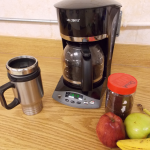by Kristin Jackson | Apr 3, 2013

Could this be one of the germiest places in your home?
In 2011, NSF International, an independent, not-for-profit organization, conducted a study with 22 families and analyzed 30 items in their homes. One item that disappointingly made NSF International’s list of the “Top Ten Germiest Places in the Home” was the coffee reservoir. This could be sad news for the approximately 239 million individuals, or 83 percent of American adults, who drank coffee in the US in 2012 (National Coffee Association).
Perk up, coffee drinkers. The good news is the solution is easy: simply clean your coffee maker according to the manufacturer’s instructions and then sanitize. Cleaning will wash/wipe away many bacteria, but sanitizing, according to the National Restaurant Association, is the process of reducing the number of microorganisms that are on a properly cleaned surface to a safe level.
You can sanitize your coffee maker using vinegar. Vinegar can be an effective sanitizing agent for your coffee maker if:
- you use white distilled vinegar (at least 5% acidity).
- the vinegar remains undiluted.
- you heat the vinegar to 130 degrees Fahrenheit or 55 degrees Celsius.
- you leave the heated vinegar on the surface for at least one minute.
 Once the vinegar has remained in the coffee reservoir for at least one minute, you can run the vinegar through the coffee maker. In order to remove the vinegar odor and taste, you may want to follow with a few cycles of clean water. Remember, the water must be clean and you should air dry the reservoir or use a clean paper towel to dry.
Once the vinegar has remained in the coffee reservoir for at least one minute, you can run the vinegar through the coffee maker. In order to remove the vinegar odor and taste, you may want to follow with a few cycles of clean water. Remember, the water must be clean and you should air dry the reservoir or use a clean paper towel to dry.
Now that you know how simple the process is, you are probably wondering how frequently you should take on the task. According to the National Restaurant Association, you should you sanitize:
- after each use
- anytime as necessary
- after 4 hours in use
So now you see how simple it is to keep the coffee maker from being one of the germiest places in your home. To find out other ways to clean and sanitize your kitchen, visit http://edis.ifas.ufl.edu/pdffiles/FY/FY128000.pdf and read Cleaning and Sanitizing the Kitchen: Using Inexpensive Household Food-safe Products. If you have any additional questions or concerns, you can contact your local Family and Consumer Sciences Agent (http://solutionsforyourlife.ufl.edu/map/ ).
References:
NSF International (2004). Top Ten Germiest Places in the Home. Retrieved 26 March 2013 from http://www.nsf.org/consumer/newsroom/fact_top10_germiest_places.asp
ServSafe Essentials 6th Edition. 2011. ISBN-13: 978-0133075687
Janet Buffer, Lydia Medeiros, Mary Schroeder, Patricia Kendall, Jeff LeJeune, and John Sofos; adapted by Amy Simonne for use in Florida with permission. FCS8 OH 2010. Cleaning and Sanitizing the Kitchen: Using Inexpensive Household Food-safe Products. Retrieved 26 March 2013 from http://edis.ifas.ufl.edu/pdffiles/FY/FY128000.pdf
Yang, H., Kendall, P., Medeiros, L., Sofos, J. (2009) Inactivation of Listeria monocytogenes, Escherichia coli O157:H7, and Salmonella Typhimurium with compounds available in households. J. Food Prot. 72(6); 1201-1208
by Shelley Swenson | Jul 23, 2012

Photo by Les Harrison, Wakulla County Extension Director
Welcome to the Florida summer!!! Feeling the heat? No pool to cool off in? Running your air conditioner and then feeling blue when the bill arrives? Let’s review some basics in energy-efficient use of your air conditioner. Perhaps you and your family could make some small changes that could result in money being saved. Quick Facts: Did you know that…..
- Heating, ventilation and air conditioning (HVAC) account for more than 40% of your utility bill?
- For every degree setting below 78˚F, you spend up to 8% more in cooling costs?
- Upgrading your system can reduce your air conditioning costs by a significant amount. Is it time to consider doing so?
Short-term solutions to improve the efficiency of your existing system include…..
- Set your thermostat at 78˚ F or higher.
- Use bath and kitchen fans sparingly when the air conditioner is operating.
- Inspect and clean both the indoor and outdoor coils. The indoor coil in your air conditioner acts as a magnet for dust because it is constantly wetted during the cooling season. Dirt build-up on the indoor coil is the single most common cause of poor efficiency. The outdoor coil also must be checked periodically for dirt build-up and cleaned if necessary.
- Shade east and west windows.
- Delay heat-generating activities, such as dishwashing and drying clothes in a clothes dryer, until the evening on hot days.
- During most of the cooling season, keep the house closed tight during the day.
- Try not to use a dehumidifier at the same time your air conditioner is operating. It increases the cooling load and forces the air conditioner to work harder.
- Consider installing ceiling fans to circulate the air more effectively. The improved circulation will make you feel cooler.
- Install a programmable thermostat. You can then schedule the time blocks during which your heating or air-conditioning system operates. As a result, you can set the equipment to more economical settings—such as lower temperatures in winter while you are asleep or when you are away from home. Choose one that can store and repeat multiple daily settings, so that you can have both a workday and a weekend heating/cooling timetable.
We have such great resources from our UF/IFAS Specialists available to you. This article was adapted from Factsheet FCS 3262 Energy Efficient Homes: Air Conditioning This publication includes information on understanding terms used in the industry, how to purchase a new unit, and questions you should be prepared to ask and answer when working with a HVAC representative. Contact your County Extension Family and Consumer Sciences Agent with further questions or for a copy of this factsheet. For additional factsheets on energy efficiency and other topics, visit http://edis.ifas.ufl.edu.
Author: Shelley Swenson, Family and Consumer Sciences/EFNEP Agent, UF/IFAS Wakulla County Extension

Shelley Swenson
UF/IFAS Extension Wakulla County
Family and Consumer Sciences/EFNEP Agent
 Once the vinegar has remained in the coffee reservoir for at least one minute, you can run the vinegar through the coffee maker. In order to remove the vinegar odor and taste, you may want to follow with a few cycles of clean water. Remember, the water must be clean and you should air dry the reservoir or use a clean paper towel to dry.
Once the vinegar has remained in the coffee reservoir for at least one minute, you can run the vinegar through the coffee maker. In order to remove the vinegar odor and taste, you may want to follow with a few cycles of clean water. Remember, the water must be clean and you should air dry the reservoir or use a clean paper towel to dry.


